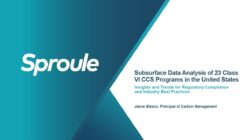Insights and Trends for Regulatory Compliance and Industry Best Practices
Subsurface Data Analysis of 23 Class VI CCS Programs in the United States
Are you interested in unveiling the critical insights and trends shaping the future of Carbon Capture and Storage (CCS) in the United States? Through meticulous analysis and a deep dive into the subsurface data of 23 Class VI CCS programs across 8 U.S. states, our team offers a comprehensive overview of the current landscape and the path forward for regulatory compliance and industry best practices.
This presentation provides an in-depth analysis of publicly available regulatory documents from various CCS programs. The presentation examines Project Narratives, MRV (Monitoring, Reporting, and Verification) reports, Area of Review (AoR), Corrective Action studies, and Pre-Operational Testing plans. Despite challenges such as redacted documents and varying documentation levels, significant trends and insights are provided, crucial for advancing CCS initiatives.
Key Takeaways:
- Pilot Holes as a Guiding Light: Only 35% of the reviewed CCS programs included pilot holes, yet their presence strongly indicates federal funding and strategic planning.
- Not So Much What, But When: Some groups delayed data acquisition or will not acquire key data types (i.e. 3D seismic data), which may cause permitting delays or deviation of injection performance from the original plan.
- Legacy vs. Advanced Subsurface Data: While legacy petrophysical logs were prevalent, only 39% of programs utilized advanced logging techniques, underscoring a gap in capturing detailed subsurface information.
- Core Data’s Dual Nature: The analysis revealed that 57% of programs had core data within AoR boundaries, split between legacy and newly acquired data, indicating a blend of historical and contemporary insights.
- Dynamic Well Test Information: Despite its importance, dynamic well test data was found in only 39% of the programs, with a significant portion coming from legacy oil and gas wells.
- Seismic Data Coverage: The availability of seismic data varied, with a majority having access to 2D and 3D seismic data, although much of it was considered legacy.
These findings underscore the complex balance between meeting regulatory requirements, leveraging economic opportunities, and navigating the uncertainties inherent in pioneering CCS programs. As the industry evolves, the insights from this presentation will serve as a foundation for developing more rigorous regulatory guidelines and establishing best practices that ensure the success of future CCS initiatives.
Download the presentation slides now to Gain full access to a comprehensive analysis and explore the detailed insights shaping the future of Carbon Capture and Storage.


